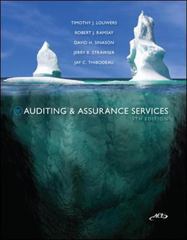Answered step by step
Verified Expert Solution
Question
1 Approved Answer
please help- I am on chapter 6 but I know all of the prior information is needed. Processing Accounting Information SERIAL PROBLEM: KATE'S CARDS Vote:
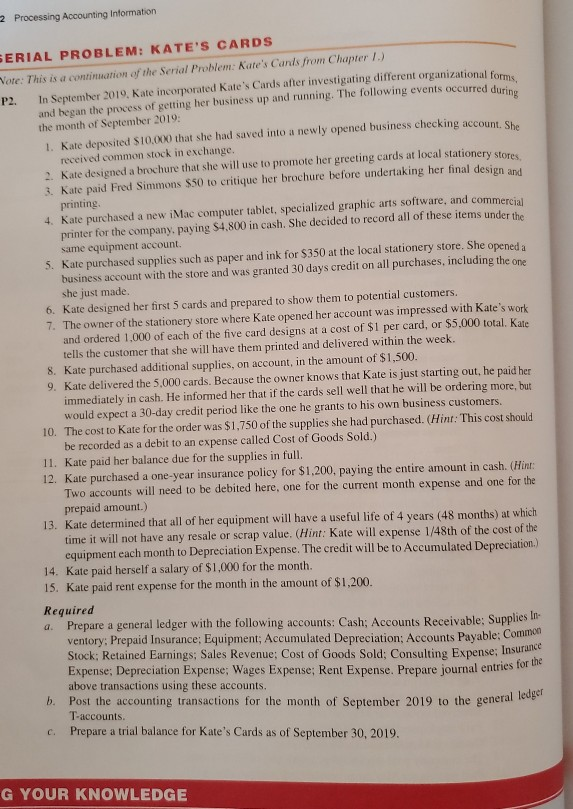
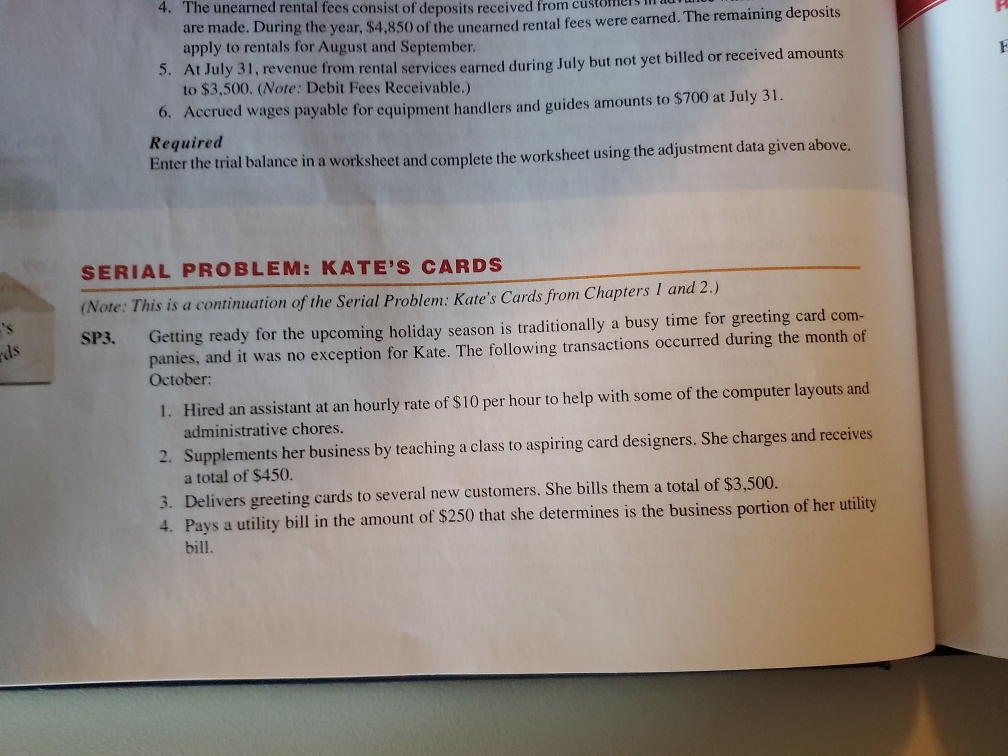
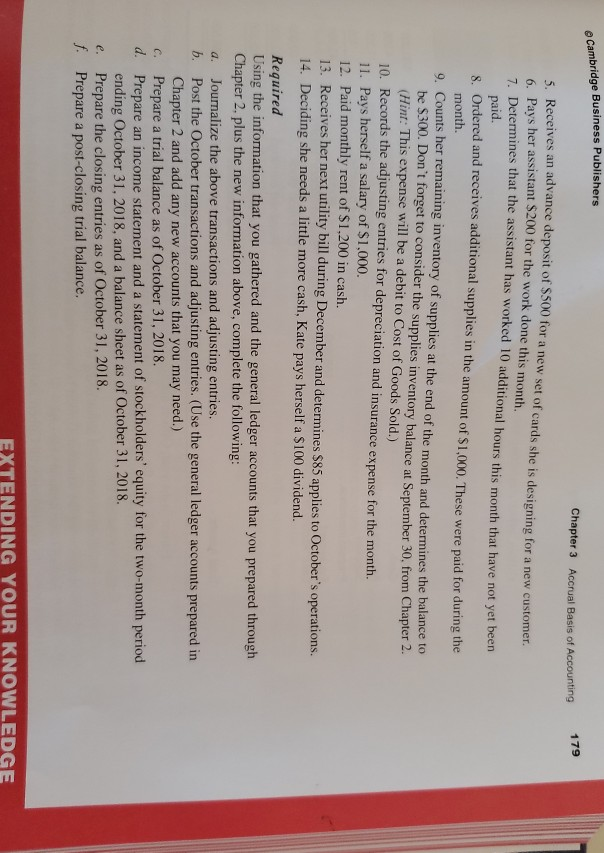
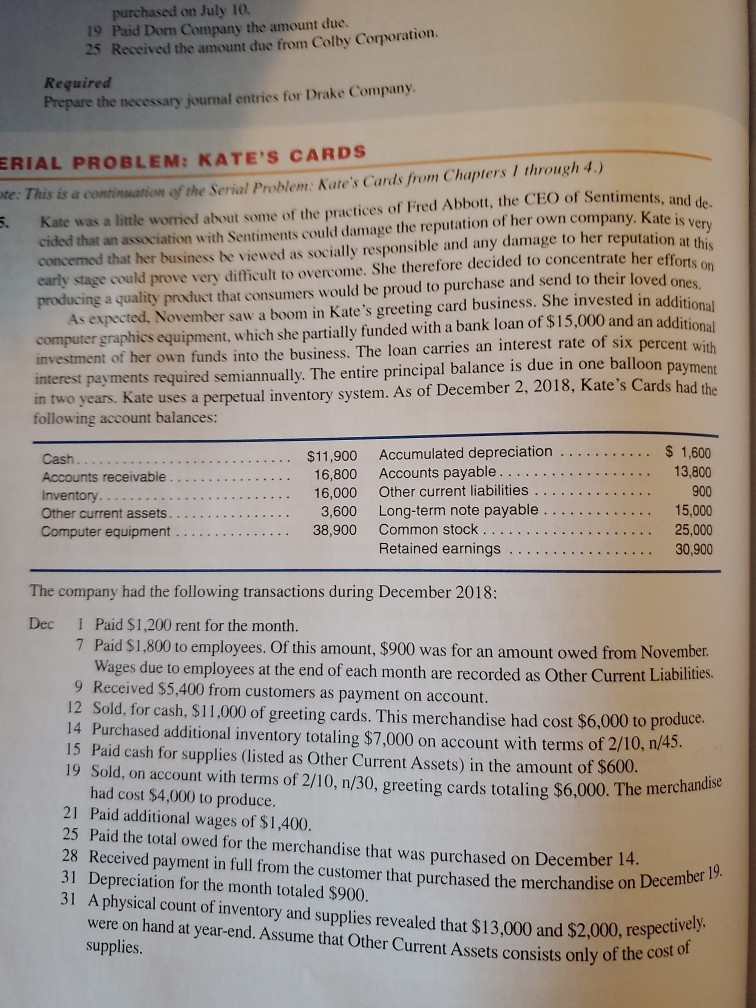

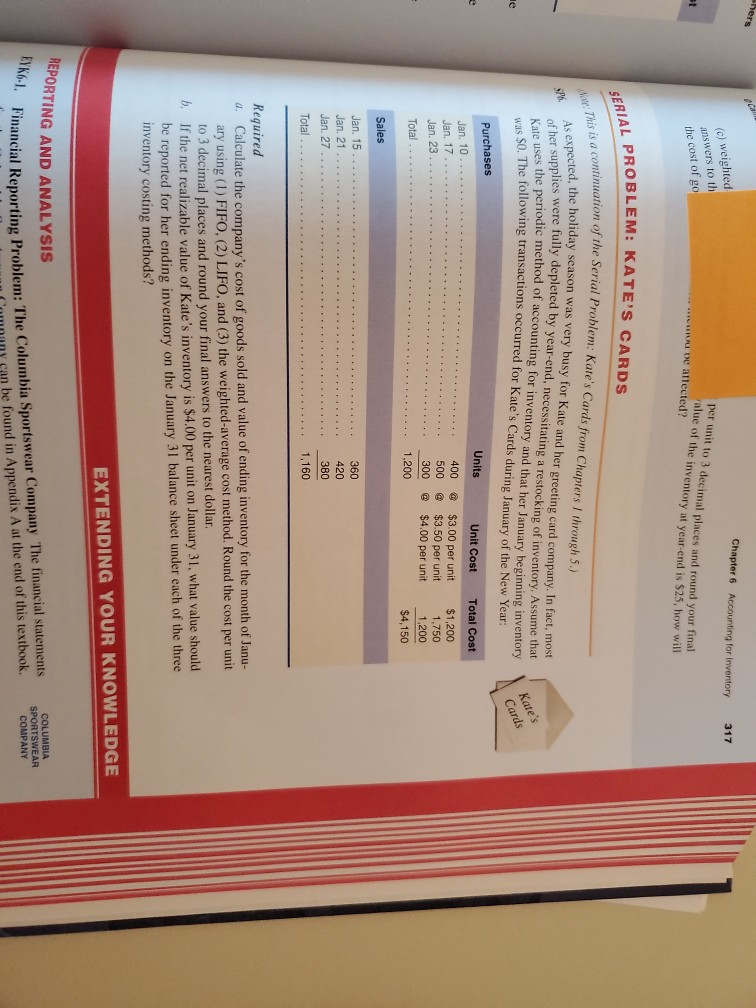
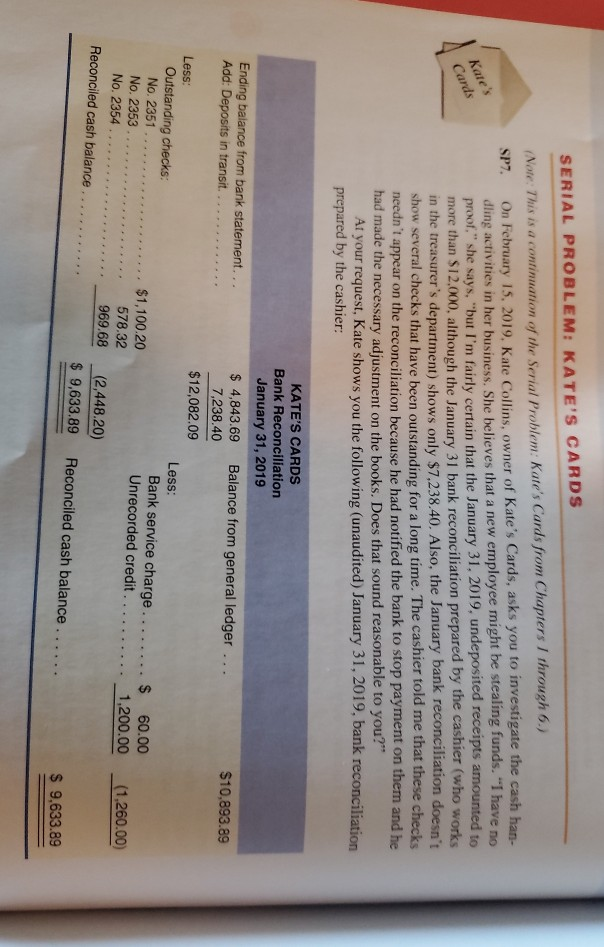
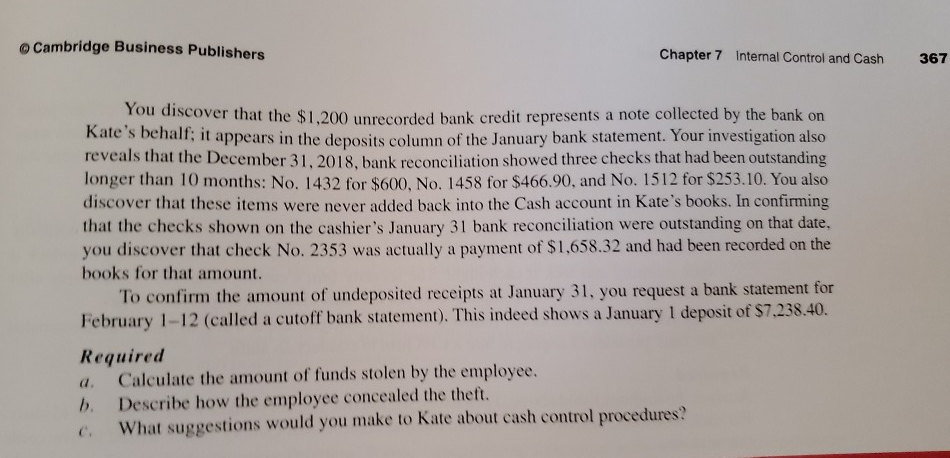
please help- I am on chapter 6 but I know all of the prior information is needed.
Processing Accounting Information SERIAL PROBLEM: KATE'S CARDS Vote: This is a continuation of the Serial Problem: Kate's Cards from Chapter 1.) P2 In September 2019 Kate incorporated Kate's Cards after investigating different organizational fed and began the process of getting her business up and running. The following events occurred du the month of September 2019: 1. Kate deposited $10.000 that she had saved into a newly opened business checking account. She received common stock in exchange. 2. Kate designed a brochure that she will use to promote her greeting cards at local stationery stores Kate paid Fred Simmons $50 to critique her brochure before undertaking her final design anul printing. 4 Kate purchased a new iMac computer tablet, specialized graphic arts software, and commercial printer for the company, paying $4.800 in cash. She decided to record all of these items under the same equipment account. 5. Kate purchased supplies such as paper and ink for $350 at the local stationery store. She opened business account with the store and was granted 30 days credit on all purchases, including the one she just made. 0. Kate designed her first 5 cards and prepared to show them to potential customers 7. The owner of the stationery store where Kate opened her account was impressed with Kate's work and ordered 1.000 of each of the five card designs at a cost of $1 per card, or $5.000 total. Kate tells the customer that she will have them printed and delivered within the week. 8. Kate purchased additional supplies, on account, in the amount of $1,500. 9. Kate delivered the 5,000 cards. Because the owner knows that Kate is just starting out, he paid her immediately in cash. He informed her that if the cards sell well that he will be ordering more, but would expect a 30-day credit period like the one he grants to his own business customers. 10. The cost to Kate for the order was $1,750 of the supplies she had purchased. (Hint: This cost should be recorded as a debit to an expense called Cost of Goods Sold.) 11. Kate paid her balance due for the supplies in full. 12. Kate purchased a one-year insurance policy for $1,200, paying the entire amount in cash. (Hint: Two accounts will need to be debited here, one for the current month expense and one for the prepaid amount.) 13. Kate determined that all of her equipment will have a useful life of 4 years (48 months) at which time it will not have any resale or scrap value. (Hint: Kate will expense 1/48th of the cost of the equipment each month to Depreciation Expense. The credit will be to Accumulated Depreciation) 14. Kate paid herself a salary of $1,000 for the month. 15. Kate paid rent expense for the month in the amount of $1,200. Required a. Prepare a general ledger with the following accounts: Cash; Accounts Receivable: Supplies ventory: Prepaid Insurance; Equipment; Accumulated Depreciation: Accounts Payable: Comm Stock; Retained Earnings: Sales Revenue; Cost of Goods Sold: Consulting Expense; Insur Expense; Depreciation Expense; Wages Expense; Rent Expense. Prepare journal entries to above transactions using these accounts. the general ledger b. Post the accounting transactions for the month of September 2019 to the general T-accounts. c. Prepare a trial balance for Kate's Cards as of September 30, 2019. G YOUR KNOWLEDGE 4. The unearned rental fees consist of deposits received from customers illu are made. During the year. $4.850 of the unearned rental fees were earned. apply to rentals for August and September 3. At July 31, revenue from rental services earned during July but not yet billed or received amounts to $3,500. (Note: Debit Fees Receivable.) 6. Accrued wages payable for equipment handlers and guides amounts to $700 at July 31. Required Enter the trial balance in a worksheet and complete the worksheet using the adjustment data given above. SERIAL PROBLEM: KATE'S CARDS (Note: This is a continuation of the Serial Problem: Kate's Cards from Chapters 1 and 2.) SP3. Getting ready for the upcoming holiday season is traditionally a busy time for greeting card com- panies, and it was no exception for Kate. The following transactions occurred during the month of October: 1. Hired an assistant at an hourly rate of $10 per hour to help with some of the computer layouts and administrative chores. 2. Supplements her business by teaching a class to aspiring card designers. She charges and receives a total of $450. 3. Delivers greeting cards to several new customers. She bills them a total of $3,500. 4. Pays a utility bill in the amount of $250 that she determines is the business portion of her utility bill. Cambridge Business Publishers Chapter 3 Accrual Basis of Accounting 1 Receives an advance deposit of $500 for a new set of cards she is designing for a new customer. 6. Pays her assistant $200 for the work done this month. - Determines that the assistant has worked 10 additional hours this month that have not yet been paid. 8. Ordered and receives additional supplies in the amount of $1.000. These were paid for during the month. 9 Counts her remaining inventory of supplies at the end of the month and determines the balance to he $300. Don't forget to consider the supplies inventory balance at September 30, from Chapter - (Hint: This expense will be a debit to Cost of Goods Sold.) 10. Records the adjusting entries for depreciation and insurance expense for the month. 11. Pays herself a salary of $1,000. 12. Paid monthly rent of $1,200 in cash. 13. Receives her next utility bill during December and determines $85 applies to October 's operations. 14. Deciding she needs a little more cash, Kate pays herself a $100 dividend. Required Using the information that you gathered and the general ledger accounts that you prepared through Chapter 2, plus the new information above, complete the following: a. Journalize the above transactions and adjusting entries. b. Post the October transactions and adjusting entries. (Use the general ledger accounts prepared in Chapter 2 and add any new accounts that you may need.) c. Prepare a trial balance as of October 31, 2018. d. Prepare an income statement and a statement of stockholders' equity for the two-month period ending October 31, 2018, and a balance sheet as of October 31, 2018. e. Prepare the closing entries as of October 31, 2018. f. Prepare a post-closing trial balance. EXTENDING YOUR KNOWLEDGE purchased on July 10. 19 Paid Dom Company the amount due. 25 Received the amount due from Colby Corporation. Required Prepare the necessary journal entries for Drake Company iments, and de wy. Kate is very ERIAL PROBLEM: KATE'S CARDS ote: This is a contination of the Serial Problem: Kate's Cards from Chapters / through 4.) 5. Kate was a little worried about some of the practices of Fred Abbott, the CEO of Sentiments, and cided that an association with Sentiments could damage the reputation of her own company. Kate is concemed that her business be viewed as socially responsible and any damage to her reputation at early stage could prove very difficult to overcome. She therefore decided to concentrate her effor producing a quality product that consumers would be proud to purchase and send to their loved one As expected, November saw a boom in Kate's greeting card business. She invested in additin computer graphics equipment, which she partially funded with a bank loan of $15,000 and an additio investment of her own funds into the business. The loan carries an interest rate of six percent with interest payments required semiannually. The entire principal balance is due in one balloon Davman in two years. Kate uses a perpetual inventory system. As of December 2, 2018, Kate's Cards had the following account balances: Cash........ Accounts receivable........ inventory................. Other current assets....... Computer equipment ...... $11,900 16,800 16,000 3,600 38,900 Accumulated depreciation ... Accounts payable......... Other current liabilities ...... Long-term note payable ..... Common stock .......... Retained earnings ........ $ 1,600 13,800 900 15,000 25,000 30,900 The company had the following transactions during December 2018: Dec 1 Paid $1,200 rent for the month. 7 Paid $1,800 to employees. Of this amount, $900 was for an amount owed from November Wages due to employees at the end of each month are recorded as Other Current Liabilities 9 Received $5,400 from customers as payment on account. 12 Sold, for cash, $11,000 of greeting cards. This merchandise had cost $6,000 to produce. 14 Purchased additional inventory totaling $7,000 on account with terms of 2/10, n/45. 15 Paid cash for supplies (listed as Other Current Assets) in the amount of $600. 19 Sold, on account with terms of 2/10, n/30, greeting cards totaling $6,000. The merch had cost $4,000 to produce. 21 Paid additional wages of $1,400. 25 Paid the total owed for the merchandise that was purchased on December 14. 28 Received payment in full from the customer that purchased the merchandise on Day 31 Depreciation for the month totaled $900. 31 A physical count of inventory and supplies revealed that $13.000 and $2,000, respeon were on hand at year-end. Assume that Other Current Assets consists only of the supplies. cards totaling $6,000. The merchandise adise on December 19. 10 and $2,000, respectively, Cambridge Business Publishers Chapter 5 Accounting for Merchandising Required a. Prepare journal entries for the December transactions. b. Prepare a classified income statement for the month of December 2018. C. Calculate Kate's gross profit percentage and return on sales ratio for December 2018. EXTENDING YOUR (c) weighted answers to th the cost of go Chapter 6 Accounting for Inventory per unit to 3 decimal places and round your final alue of the inventory at year end is 525, how will allected? 317 AL PROBLEM: KATE'S CARDS SERIAL PROR This is a continuation of the Serial Problem: ont of the Serial Problem: Kate's Cards from Chapters / through 5.) XX of her supplies were fully deplete Kate uses the periodic mer expected, the holiday season was very busy for Kate and her greeting card company. In fact, most upplies were fully depleted by year-end, necessitating a restocking of inventory. Assume that ses the periodic method of accounung for inventory and that her January beginning inventory The following transactions occurred for Kate's Cards during January of the New Year: Purchases Kate's Cards Units Jan. 10 Jan. 17. Jan. 23. Total 400 500 300 Unit Cost $3.00 per unit $3.50 per unit $4.00 per unit Total Cost $1,200 @ Sales 1.200 1,750 1.200 $4,150 Jan. 15... Jan. 21 Jan. 27 Total 360 420 380 1,160 Reguired 4. Calculate the company's cost of goods sold and value of ending inventory for the month of Janu- ary using (1) FIFO, (2) LIFO, and (3) the weighted average cost method. Round the cost per unit to 3 decimal places and round your final answers to the nearest dollar B. If the net realizable value of Kate's inventory is $4.00 per unit on January 31, what value should be reported for her ending inventory on the January 31 balance sheet under each of the three inventory costing methods? EXTENDING YOUR KNOWLEDGE REPORTING AND ANALYSIS EYK6-1. Financial Reportin Financial Reporting Problem: The Columbia Sportswear Company The financial statements ww w.can be found in Appendix A at the end of this textbook. COLUMBIA SPORTSWEAR COMPANY SERIAL PROBLEM: KATE'S CARDS Kate's Cards (Note: This is a continuation of the Serial Problem: Kate's Cards from Chapters / through 6.) SP7. On February 15, 2019. Kate Collins, owner of Kate's Cards, asks you to investigate the cash han- dling activities in her business. She believes that a new employee might be stealing funds. "I have no proof." she says, "but I'm fairly certain that the January 31, 2019, undeposited receipts amounted to more than $12,000, although the January 31 bank reconciliation prepared by the cashier (who works in the treasurer's department) shows only $7.238.40. Also, the January bank reconciliation doesn't show several checks that have been outstanding for a long time. The cashier told me that these checks needn't appear on the reconciliation because he had notified the bank to stop payment on them and he had made the necessary adjustment on the books. Does that sound reasonable to you? Ar your request, Kate shows you the following (unaudited) January 31, 2019, bank reconciliation prepared by the cashier: Ending balance from bank statement... Add: Deposits in transit. $10,893.89 Less: Outstanding checks: No. 2351 No. 2353 No. 2354 Reconciled cash balance.. KATE'S CARDS Bank Reconciliation January 31, 2019 $ 4,843.69 Balance from general ledger .. 7,238.40 $12,082.09 Less: Bank service charge. . . . . . . . $ 60.00 Unrecorded credit .. 1,200.00 (2,448.20) $ 9,633.89 Reconciled cash balance ...... $1,100.20 578.32 969.68 (1.260.00 $ 9,633.89 Cambridge Business Publishers Chapter 7 Internal Control and Cash 367 over that the $1,200 unrecorded bank credit represents a note collected by the bank on h t, it appears in the deposits column of the January bank statement. Your investigation also als that the December 31, 2018, bank reconciliation showed three checks that had been outstanding longer than 10 months: No. 1432 for $600, No. 1458 for $466.90, and No. 1512 for $253.10. You also discover that these items were never added back into the Cash account in Kate's books. In confirming that the checks shown on the cashier's January 31 bank reconciliation were outstanding on that date, you discover that check No. 2353 was actually a payment of $1.658.32 and had been recorded on the books for that amount. To confirm the amount of undeposited receipts at January 31, you request a bank statement for February 1-12 (called a cutoff bank statement). This indeed shows a January 1 deposit of $7.238.40. Required a. Calculate the amount of funds stolen by the employee, b. Describe how the employee concealed the theft. C. What suggestions would you make to Kate about cash control procedures? Processing Accounting Information SERIAL PROBLEM: KATE'S CARDS Vote: This is a continuation of the Serial Problem: Kate's Cards from Chapter 1.) P2 In September 2019 Kate incorporated Kate's Cards after investigating different organizational fed and began the process of getting her business up and running. The following events occurred du the month of September 2019: 1. Kate deposited $10.000 that she had saved into a newly opened business checking account. She received common stock in exchange. 2. Kate designed a brochure that she will use to promote her greeting cards at local stationery stores Kate paid Fred Simmons $50 to critique her brochure before undertaking her final design anul printing. 4 Kate purchased a new iMac computer tablet, specialized graphic arts software, and commercial printer for the company, paying $4.800 in cash. She decided to record all of these items under the same equipment account. 5. Kate purchased supplies such as paper and ink for $350 at the local stationery store. She opened business account with the store and was granted 30 days credit on all purchases, including the one she just made. 0. Kate designed her first 5 cards and prepared to show them to potential customers 7. The owner of the stationery store where Kate opened her account was impressed with Kate's work and ordered 1.000 of each of the five card designs at a cost of $1 per card, or $5.000 total. Kate tells the customer that she will have them printed and delivered within the week. 8. Kate purchased additional supplies, on account, in the amount of $1,500. 9. Kate delivered the 5,000 cards. Because the owner knows that Kate is just starting out, he paid her immediately in cash. He informed her that if the cards sell well that he will be ordering more, but would expect a 30-day credit period like the one he grants to his own business customers. 10. The cost to Kate for the order was $1,750 of the supplies she had purchased. (Hint: This cost should be recorded as a debit to an expense called Cost of Goods Sold.) 11. Kate paid her balance due for the supplies in full. 12. Kate purchased a one-year insurance policy for $1,200, paying the entire amount in cash. (Hint: Two accounts will need to be debited here, one for the current month expense and one for the prepaid amount.) 13. Kate determined that all of her equipment will have a useful life of 4 years (48 months) at which time it will not have any resale or scrap value. (Hint: Kate will expense 1/48th of the cost of the equipment each month to Depreciation Expense. The credit will be to Accumulated Depreciation) 14. Kate paid herself a salary of $1,000 for the month. 15. Kate paid rent expense for the month in the amount of $1,200. Required a. Prepare a general ledger with the following accounts: Cash; Accounts Receivable: Supplies ventory: Prepaid Insurance; Equipment; Accumulated Depreciation: Accounts Payable: Comm Stock; Retained Earnings: Sales Revenue; Cost of Goods Sold: Consulting Expense; Insur Expense; Depreciation Expense; Wages Expense; Rent Expense. Prepare journal entries to above transactions using these accounts. the general ledger b. Post the accounting transactions for the month of September 2019 to the general T-accounts. c. Prepare a trial balance for Kate's Cards as of September 30, 2019. G YOUR KNOWLEDGE 4. The unearned rental fees consist of deposits received from customers illu are made. During the year. $4.850 of the unearned rental fees were earned. apply to rentals for August and September 3. At July 31, revenue from rental services earned during July but not yet billed or received amounts to $3,500. (Note: Debit Fees Receivable.) 6. Accrued wages payable for equipment handlers and guides amounts to $700 at July 31. Required Enter the trial balance in a worksheet and complete the worksheet using the adjustment data given above. SERIAL PROBLEM: KATE'S CARDS (Note: This is a continuation of the Serial Problem: Kate's Cards from Chapters 1 and 2.) SP3. Getting ready for the upcoming holiday season is traditionally a busy time for greeting card com- panies, and it was no exception for Kate. The following transactions occurred during the month of October: 1. Hired an assistant at an hourly rate of $10 per hour to help with some of the computer layouts and administrative chores. 2. Supplements her business by teaching a class to aspiring card designers. She charges and receives a total of $450. 3. Delivers greeting cards to several new customers. She bills them a total of $3,500. 4. Pays a utility bill in the amount of $250 that she determines is the business portion of her utility bill. Cambridge Business Publishers Chapter 3 Accrual Basis of Accounting 1 Receives an advance deposit of $500 for a new set of cards she is designing for a new customer. 6. Pays her assistant $200 for the work done this month. - Determines that the assistant has worked 10 additional hours this month that have not yet been paid. 8. Ordered and receives additional supplies in the amount of $1.000. These were paid for during the month. 9 Counts her remaining inventory of supplies at the end of the month and determines the balance to he $300. Don't forget to consider the supplies inventory balance at September 30, from Chapter - (Hint: This expense will be a debit to Cost of Goods Sold.) 10. Records the adjusting entries for depreciation and insurance expense for the month. 11. Pays herself a salary of $1,000. 12. Paid monthly rent of $1,200 in cash. 13. Receives her next utility bill during December and determines $85 applies to October 's operations. 14. Deciding she needs a little more cash, Kate pays herself a $100 dividend. Required Using the information that you gathered and the general ledger accounts that you prepared through Chapter 2, plus the new information above, complete the following: a. Journalize the above transactions and adjusting entries. b. Post the October transactions and adjusting entries. (Use the general ledger accounts prepared in Chapter 2 and add any new accounts that you may need.) c. Prepare a trial balance as of October 31, 2018. d. Prepare an income statement and a statement of stockholders' equity for the two-month period ending October 31, 2018, and a balance sheet as of October 31, 2018. e. Prepare the closing entries as of October 31, 2018. f. Prepare a post-closing trial balance. EXTENDING YOUR KNOWLEDGE purchased on July 10. 19 Paid Dom Company the amount due. 25 Received the amount due from Colby Corporation. Required Prepare the necessary journal entries for Drake Company iments, and de wy. Kate is very ERIAL PROBLEM: KATE'S CARDS ote: This is a contination of the Serial Problem: Kate's Cards from Chapters / through 4.) 5. Kate was a little worried about some of the practices of Fred Abbott, the CEO of Sentiments, and cided that an association with Sentiments could damage the reputation of her own company. Kate is concemed that her business be viewed as socially responsible and any damage to her reputation at early stage could prove very difficult to overcome. She therefore decided to concentrate her effor producing a quality product that consumers would be proud to purchase and send to their loved one As expected, November saw a boom in Kate's greeting card business. She invested in additin computer graphics equipment, which she partially funded with a bank loan of $15,000 and an additio investment of her own funds into the business. The loan carries an interest rate of six percent with interest payments required semiannually. The entire principal balance is due in one balloon Davman in two years. Kate uses a perpetual inventory system. As of December 2, 2018, Kate's Cards had the following account balances: Cash........ Accounts receivable........ inventory................. Other current assets....... Computer equipment ...... $11,900 16,800 16,000 3,600 38,900 Accumulated depreciation ... Accounts payable......... Other current liabilities ...... Long-term note payable ..... Common stock .......... Retained earnings ........ $ 1,600 13,800 900 15,000 25,000 30,900 The company had the following transactions during December 2018: Dec 1 Paid $1,200 rent for the month. 7 Paid $1,800 to employees. Of this amount, $900 was for an amount owed from November Wages due to employees at the end of each month are recorded as Other Current Liabilities 9 Received $5,400 from customers as payment on account. 12 Sold, for cash, $11,000 of greeting cards. This merchandise had cost $6,000 to produce. 14 Purchased additional inventory totaling $7,000 on account with terms of 2/10, n/45. 15 Paid cash for supplies (listed as Other Current Assets) in the amount of $600. 19 Sold, on account with terms of 2/10, n/30, greeting cards totaling $6,000. The merch had cost $4,000 to produce. 21 Paid additional wages of $1,400. 25 Paid the total owed for the merchandise that was purchased on December 14. 28 Received payment in full from the customer that purchased the merchandise on Day 31 Depreciation for the month totaled $900. 31 A physical count of inventory and supplies revealed that $13.000 and $2,000, respeon were on hand at year-end. Assume that Other Current Assets consists only of the supplies. cards totaling $6,000. The merchandise adise on December 19. 10 and $2,000, respectively, Cambridge Business Publishers Chapter 5 Accounting for Merchandising Required a. Prepare journal entries for the December transactions. b. Prepare a classified income statement for the month of December 2018. C. Calculate Kate's gross profit percentage and return on sales ratio for December 2018. EXTENDING YOUR (c) weighted answers to th the cost of go Chapter 6 Accounting for Inventory per unit to 3 decimal places and round your final alue of the inventory at year end is 525, how will allected? 317 AL PROBLEM: KATE'S CARDS SERIAL PROR This is a continuation of the Serial Problem: ont of the Serial Problem: Kate's Cards from Chapters / through 5.) XX of her supplies were fully deplete Kate uses the periodic mer expected, the holiday season was very busy for Kate and her greeting card company. In fact, most upplies were fully depleted by year-end, necessitating a restocking of inventory. Assume that ses the periodic method of accounung for inventory and that her January beginning inventory The following transactions occurred for Kate's Cards during January of the New Year: Purchases Kate's Cards Units Jan. 10 Jan. 17. Jan. 23. Total 400 500 300 Unit Cost $3.00 per unit $3.50 per unit $4.00 per unit Total Cost $1,200 @ Sales 1.200 1,750 1.200 $4,150 Jan. 15... Jan. 21 Jan. 27 Total 360 420 380 1,160 Reguired 4. Calculate the company's cost of goods sold and value of ending inventory for the month of Janu- ary using (1) FIFO, (2) LIFO, and (3) the weighted average cost method. Round the cost per unit to 3 decimal places and round your final answers to the nearest dollar B. If the net realizable value of Kate's inventory is $4.00 per unit on January 31, what value should be reported for her ending inventory on the January 31 balance sheet under each of the three inventory costing methods? EXTENDING YOUR KNOWLEDGE REPORTING AND ANALYSIS EYK6-1. Financial Reportin Financial Reporting Problem: The Columbia Sportswear Company The financial statements ww w.can be found in Appendix A at the end of this textbook. COLUMBIA SPORTSWEAR COMPANY SERIAL PROBLEM: KATE'S CARDS Kate's Cards (Note: This is a continuation of the Serial Problem: Kate's Cards from Chapters / through 6.) SP7. On February 15, 2019. Kate Collins, owner of Kate's Cards, asks you to investigate the cash han- dling activities in her business. She believes that a new employee might be stealing funds. "I have no proof." she says, "but I'm fairly certain that the January 31, 2019, undeposited receipts amounted to more than $12,000, although the January 31 bank reconciliation prepared by the cashier (who works in the treasurer's department) shows only $7.238.40. Also, the January bank reconciliation doesn't show several checks that have been outstanding for a long time. The cashier told me that these checks needn't appear on the reconciliation because he had notified the bank to stop payment on them and he had made the necessary adjustment on the books. Does that sound reasonable to you? Ar your request, Kate shows you the following (unaudited) January 31, 2019, bank reconciliation prepared by the cashier: Ending balance from bank statement... Add: Deposits in transit. $10,893.89 Less: Outstanding checks: No. 2351 No. 2353 No. 2354 Reconciled cash balance.. KATE'S CARDS Bank Reconciliation January 31, 2019 $ 4,843.69 Balance from general ledger .. 7,238.40 $12,082.09 Less: Bank service charge. . . . . . . . $ 60.00 Unrecorded credit .. 1,200.00 (2,448.20) $ 9,633.89 Reconciled cash balance ...... $1,100.20 578.32 969.68 (1.260.00 $ 9,633.89 Cambridge Business Publishers Chapter 7 Internal Control and Cash 367 over that the $1,200 unrecorded bank credit represents a note collected by the bank on h t, it appears in the deposits column of the January bank statement. Your investigation also als that the December 31, 2018, bank reconciliation showed three checks that had been outstanding longer than 10 months: No. 1432 for $600, No. 1458 for $466.90, and No. 1512 for $253.10. You also discover that these items were never added back into the Cash account in Kate's books. In confirming that the checks shown on the cashier's January 31 bank reconciliation were outstanding on that date, you discover that check No. 2353 was actually a payment of $1.658.32 and had been recorded on the books for that amount. To confirm the amount of undeposited receipts at January 31, you request a bank statement for February 1-12 (called a cutoff bank statement). This indeed shows a January 1 deposit of $7.238.40. Required a. Calculate the amount of funds stolen by the employee, b. Describe how the employee concealed the theft. C. What suggestions would you make to Kate about cash control proceduresStep by Step Solution
There are 3 Steps involved in it
Step: 1

Get Instant Access to Expert-Tailored Solutions
See step-by-step solutions with expert insights and AI powered tools for academic success
Step: 2

Step: 3

Ace Your Homework with AI
Get the answers you need in no time with our AI-driven, step-by-step assistance
Get Started


